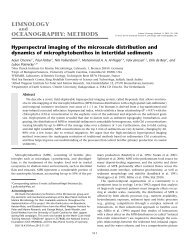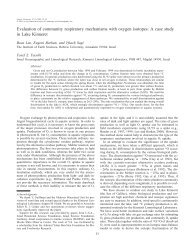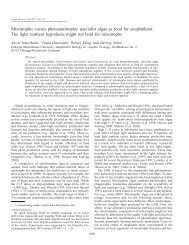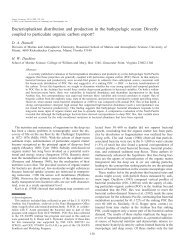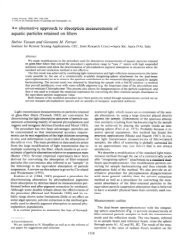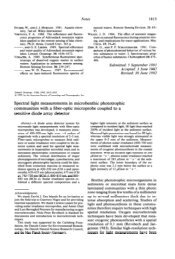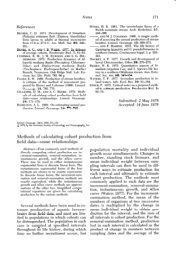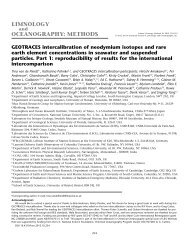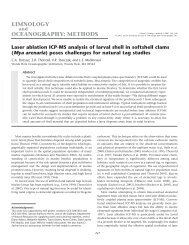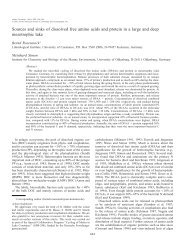Chia Yu Lin and Steven L. Manley. Bromoform production from - ASLO
Chia Yu Lin and Steven L. Manley. Bromoform production from - ASLO
Chia Yu Lin and Steven L. Manley. Bromoform production from - ASLO
Create successful ePaper yourself
Turn your PDF publications into a flip-book with our unique Google optimized e-Paper software.
MNS Keynote Lecture<br />
Thomas W. Kenny<br />
Stanford University<br />
Wednesday, August 31, 2011 Session: MNS 8<br />
10:40am–12:00pm Location: Regency C<br />
Encapsulation for MEMS Resonators: How Packaging<br />
Enabled a Technology<br />
MEMS Resonators have been studied for more than 40 years,<br />
with continuous interest in their use as frequency references.<br />
Unfortunately, the promise of MEMS resonators for these<br />
applications has always been limited by observations of drift in<br />
frequency, which has been understood to arise <strong>from</strong> the<br />
temperature coefficient of the modulus of Silicon, as well as the<br />
role of adsorbed molecules <strong>from</strong> the environment of the<br />
resonator <strong>and</strong> other nefarious effects. The temperature<br />
coefficient of the modulus of Silicon is a well-known parameter,<br />
giving rise to a ~30 ppm/C error in frequency. This error can be<br />
reduced by temperature control of the resonator, <strong>and</strong> by use of<br />
compensating materials, such as SiO2, or by electronic<br />
compensation methods. The adsorbate-induced drift in MEMS<br />
resonators can only be addressed by the development of ultraclean,<br />
hermetic packaging for the resonators. Our group has<br />
developed a wafer-scale MEMS encapsulation process that<br />
enables a solution to many of these problems with MEMS<br />
resonators. In this presentation, we will discuss the<br />
encapsulation process, <strong>and</strong> the opportunities for<br />
implementation of temperature compensation <strong>and</strong> control. The<br />
encapsulation process is inherently clean, <strong>and</strong> directly enables<br />
long-term stability. Taken together, we believe we have a<br />
pathway to the development of high-performance frequency<br />
sources that feature excellent long-term stability <strong>and</strong><br />
temperature stability, <strong>and</strong> which can be considered for<br />
commercial <strong>and</strong> defense applications.<br />
25<br />
KEYNOTE AND AWARD LECTURES<br />
Biographical Description: Thomas W. Kenny received the<br />
B.S. degree in physics <strong>from</strong> the University of Minnesota,<br />
Minneapolis, in 1983, <strong>and</strong> the M.S. <strong>and</strong> Ph.D. degrees in<br />
physics <strong>from</strong> the University of California, Berkeley, in 1987 <strong>and</strong><br />
1989, respectively. From 1989 to 1993, he was with the Jet<br />
Propulsion Laboratory, National Aeronautics <strong>and</strong> Space<br />
Administration, Pasadena, CA, where his research focused on<br />
the development of electron-tunneling high-resolution<br />
microsensors. In 1994, he joined the Department of Mechanical<br />
Engineering, Stanford University, Stanford, CA, where he directs<br />
Microsensor-based research in a variety of areas, including<br />
resonators, wafer-scale packaging, cantilever beam force<br />
sensors, microfluidics, <strong>and</strong> novel fabrication techniques for<br />
micro-mechanical structures. He is the Founder <strong>and</strong> CTO of<br />
Cooligy, Sunnyvale, CA, a microfluidics chip cooling component<br />
manufacturer, <strong>and</strong> the Founder <strong>and</strong> a Board Member of SiTime<br />
Corporation, a developer of CMOS timing references using<br />
MEMS resonators. He is currently a Stanford Bosch Faculty<br />
Development Scholar <strong>and</strong> was the General Chairman of the<br />
2006 Hilton Head Solid State Sensor, Actuator, <strong>and</strong><br />
Microsystems Workshop. From October 2006 through<br />
September 2010, he was on leave to serve as Program<br />
Manager in the Microsystems Technology Office at the Defense<br />
Advanced Research Projects Agency, starting <strong>and</strong> managing<br />
programs in thermal management, nanomanufacturing,<br />
manipulation of Casimir forces, <strong>and</strong> the Young Faculty Award.<br />
He has authored or coauthored over 250 scientific papers <strong>and</strong><br />
is a holder of 48 issued patents.




